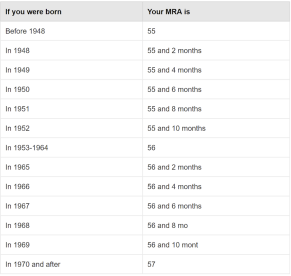
How Federal Employees Can Plan to Retire on Time
Planning for retirement shouldn’t feel like a guessing game. You should be confident that the plan in place will get you to that target. With recent inflation woes and market fluctuations, it may feel like your retirement date will need to be pushed back. But whether retirement is just around the corner or roughly a decade away, we have some tips to help you retire on time.
Know Your Retirement Age
One of the keys to retiring on time is maximizing your retirement benefits. When you retire and how long you have been in service will greatly affect the benefits you receive. If you retire before you have reached your minimum retirement age (MRA) or before you have completed enough service, you will not be able to maximize your benefits. The following chart shows your minimum retirement age:
To receive full benefits, you must either have 30 years of service and reach your MRA, or have 20 years of service and be age 60 or older. If you have between 10-30 years of service, you are allowed to retire at your MRA, but your benefits will be reduced by 5% a year for each year you are under age 62. For example, if you retire at age 56 with 19 years of service, your benefit will be reduced by 30% (5% for each of 6 years). However, if you work 4 more years and retire at age 60 with 23 years of service, you will receive the full benefit.
The amount of benefit you receive will affect your ability to retire successfully (i.e., having enough money to live on without going back to work). It is important to strategically balance your years of service and retirement age in order to receive a high enough benefit to support you during retirement. Sometimes simply working one or two more years can make a big difference in your benefit amount.
Keep Your High-Paying Job a Little Longer
Another factor in your benefit calculation is your salary. Under FERS, your pension benefit is calculated as:
(average of 3 highest years’ salary) X (years of service) X (pension multiplier)* = (annual pension benefit)
*The pension multiplier depends on your years of service and age at retirement, as discussed above.
If your salary significantly increases shortly before retirement, working a couple more years may be well worth it. Let’s say you plan to retire at age 60 with 30 years of service. One year prior, you go from earning $100,000 as you did for the previous 2 years to $120,000. If you retire as planned, your pension benefit will be:
$106,667 X 30 years X 1.1% = $35,200
If you decide to stay in that higher-paying job for two more years, your pension benefit will be:
$120,000 X 32 years X 1.1% = $42,240
Staying in the higher-paying job for at least three years to increase your benefit calculation can make a big difference in retirement. In our example, it is a $7,040 difference per year. Over a 20-year retirement, that comes out to $140,800.
Take Advantage of Your TSP Match
In addition to your FERS pension, as a federal employee, you have access to the Thrift Savings Plan (TSP). Instead of getting a promised pension amount, what you get out of it is a combination of what you put in and how you invest it, much like the popular private-sector 401(k) plan. It is your choice whether or not to contribute to the TSP and how much you put in it.
To build up the most funds for retirement, you need to contribute up to your agency’s match. Receiving a matching contribution from the government is essentially an immediate 100% gain on your money. Your agency matches your contributions up to 5% of base pay, so you should contribute at least that much. Contributing any less is leaving free money on the table, money that will fund your retirement.
Invest Your TSP for Growth
On top of getting your agency match, you want to invest your TSP funds wisely. Where you put your money over a 30-year career can make a huge difference in your account balance when it comes time to retire, and it can greatly affect your ability to do so. It may be tempting to keep your money protected from the volatility of the stock market, but that also robs you of the opportunity for your money to grow along with the stock market. Without that growth, you may not have enough funds to retire on time.
The right investments for your TSP will depend on your age, goals, and risk tolerance. There is no one-size-fits-all solution that suits everyone, so it’s wise to consult an experienced financial advisor. A financial professional can not only help you build a diversified portfolio within your TSP, but they can also help you create an overall plan and strategy to retire on time.
At Bridgerland Financial, we have years of experience navigating the complicated FERS benefits. Our goal is to help you bridge the gap between federal service and retirement. In addition, we can help you fill out your retirement paperwork at no charge! To learn more, schedule an appointment online or reach out to us at david.packer@bridgetoretire.com or (435) 535-1630.
About David
David Packer is founder and financial advisor at Bridgerland Financial, an independently managed financial firm in Utah. With 20 years of industry experience, David serves his clients by helping them bridge the gap between their working years and their retirement. He provides tailored, comprehensive financial plans to his business owner and individual clients so they can retire with confidence. David has a bachelor’s degree in finance and holds the Chartered Retirement Planning Counselor℠, CRPC® credential. Outside of the office, David loves to spend time with his wife and five kids and stay involved in his community. He currently serves on the board of directors of the Cache Valley Chamber of Commerce. He and his wife, Melonie, spent years as foster parents and eventually adopted their foster children. David loves playing and watching all kinds of sports, including officiating high school sports, and won’t turn down a good board or card game. Learn more about David by connecting with him on LinkedIn.


